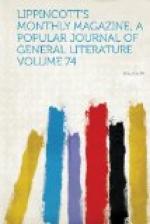of the merca is, as I have said, a hollow, the generality
of the immediate neighborhood is somewhat higher than
the level of the surrounding plain, and the eye is
thus enabled to wander far and wide over the Campagna—to
the Alban Hills southward; to the peak of Monte Cavo,
where the early rays of the sun are just touching
with light the old gray walls of the convent on its
summit; to the large village of Rocca di Papa on its
hillside a little farther to the left; to the town
of Grotto Ferrata on the lowest instep of the hill,
and more still to the left; and then Frascati, with
the heights of Tusculum above it; and thence to that
wonderfully beautiful opening in the range of hills
where Preneste lies; and beyond that, as we turn the
delighted eye slowly round to the eastward, the olive-rich
hill of Tivoli, the woods that mark the position of
Hadrian’s Villa, and the whole range of the Sabine
Hills. But little do the Roman dames care for
the scene so fair. Their eyes are all for matters
nearer at hand. They are curiously scanning the
men who are going to be the heroes of the day—the
butteri—some sitting carelessly on their
horses, some lounging around the enclosure. And
well aware are they in either case that they are the
cynosures of neighboring eyes, and the consciousness
that they are so is betrayed in every movement and
every glance of their roving eyes. Never did
knights of old enter the lists, while the heralds reminded
them that bright eyes beheld their deeds, more stimulated
to bear themselves well in the coming contest than
are these modern knights of the Campagna to show their
prowess in the ring which is to witness a not less
arduous and hardly less dangerous emprise.
At length the hospitably busy mercante di campagna
has seated all his guests, and the work of the day
may begin. Some half dozen or so of butteri and
their aids enter the arena, which is thoroughly enclosed
on all sides by high and secure palisades. The
long cloaks are discarded now, as may be supposed.
I hardly know when else the butteri are to be seen
without them or on foot. Now they are seen as
succinct as may be. Every muscle is braced up
for the coming struggle, and there may be observed
something in the faces and bearing of the men that
indicates that the work in hand is not expected to
be child’s play. They stand in a group
in the middle of the enclosed space. The day’s
work will begin with the most arduous part of it—with
that which needs all the fresh strength and address
of the men—the marking of the buffaloes.
A young buffalo bull, not yet grown to his full strength,
but yet abundantly powerful enough to be a very formidable
antagonist, is driven into the arena, and the gate
by which he has entered is immediately closed behind
him. Many a yearling of the more domesticated
breeds is a larger and heavier animal, and yet most
men would, if they were compelled to such a struggle,
prefer to measure their force against an animal of
the latter class than against this half-savage creature.




